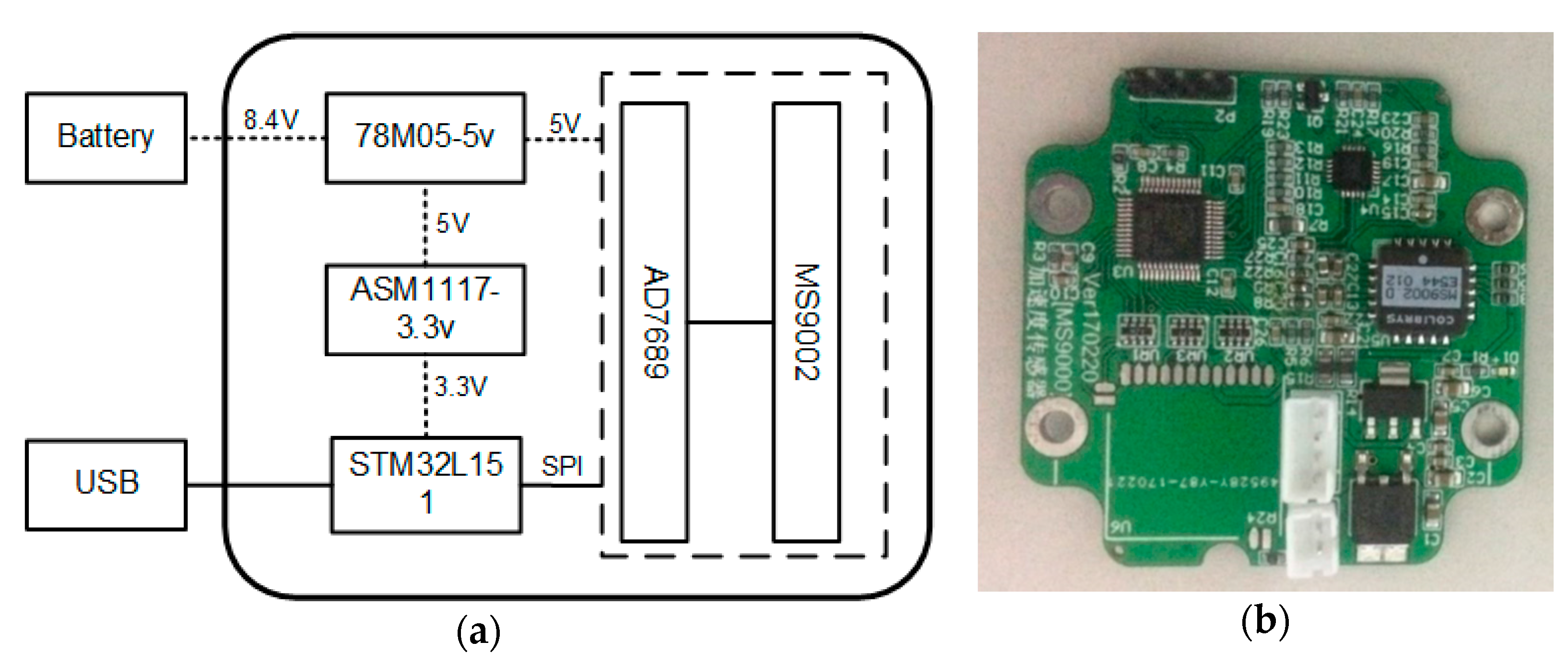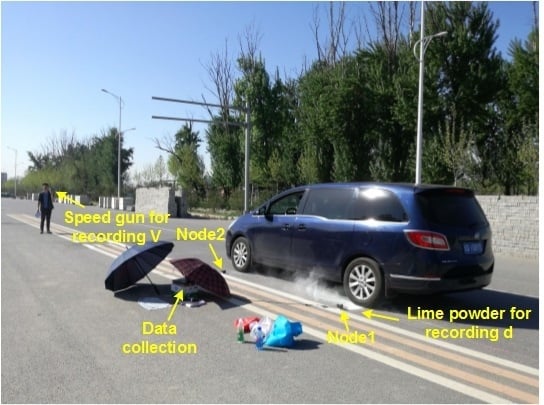Monitoring Traffic Information with a Developed Acceleration Sensing Node
Abstract
:1. Introduction
2. Objective
3. Node Development
4. Performance Testing
4.1. Encapsulation Performance Testing
- (1)
- Waterproof Testing
- (2)
- Compressive Testing
4.2. Sensing Performance Analysis
4.3. Comparison Test
5. Field Tests
5.1. Experimental Scheme
5.2. Traffic Information Monitoring
- (1)
- Speed and Wheelbase Estimate
- (2)
- Traffic Flow Monitoring
5.3. Error Analysis
- (1)
- Controlled Vehicle Speed (V = 54–56 km/h) and Changed d Value
- (2)
- The d Value (d = 28–33 cm) Is Controlled and Vehicle Speed Is Changed
- (3)
- Correlation and Variance Analysis
6. Conclusions
- (1)
- Node component selection, hardware design, and node encapsulation are accomplished. The waterproof and compression tests are carried out and sensing performance is analyzed. These tests have validated that the sensing nodes can be applied in the real road environment.
- (2)
- The acceleration sensing node is applied to practical pavement vibration monitoring. Efficient algorithms have also been proposed to process the vibration data generated by three types of vehicles. The vehicle speed, vehicle type, and traffic flow can be accurately estimated.
- (3)
- The vibration amplitude is positively correlated with vehicle weight and speed and negatively correlated with d. The average errors of speed and wheelbase are 1.11% and 1.32%, respectively, when the vibration amplitude becomes larger than 3.5 mg. The errors of speed and wheelbase become prominently larger when the vibration amplitude is smaller than 3.5 mg, which can be set as a threshold value to obtain accurate monitoring.
- (4)
- For future work, acceleration sensing nodes can be fitted with a wireless transmission module to transmit the vibration data higher than a threshold value. Therefore, the communication power consumption can be reduced and remote monitoring can be facilitated. Besides this, multiple sensing nodes will be deployed optimally to monitor traffic and infrastructure information under various environmental and loading conditions.
Acknowledgments
Author Contributions
Conflicts of Interest
References
- Wan, Y.; Huang, Y.; Buckles, B. Camera calibration and vehicle tracking: Highway traffic video analytics. Transp. Res. Part C Emerg. Technol. 2014, 44, 202–213. [Google Scholar] [CrossRef]
- Wang, Z.; Xu, J.; Huang, Z.; Zhang, X.; Xia, X.G.; Long, T.; Bao, Q. Road-Aided Ground Slowly Moving Target 2D Motion Estimation for Single-Channel Synthetic Aperture Radar. Sensors 2016, 16, 383. [Google Scholar] [CrossRef] [PubMed]
- Zhang, B.; Wang, C.; Zhang, H.; Wu, F.; Tang, Y.X. Detectability Analysis of Road Vehicles in Radarsat-2 Fully Polarimetric SAR Images for Traffic Monitoring. Sensors 2017, 17. [Google Scholar] [CrossRef] [PubMed]
- Malekzadeh, M.; Gul, M.; Kwon, I.B.; Catbas, N. An integrated approach for structural health monitoring using an in-house built fiber optic system and non-parametric data analysis. Smart Struct. Syst. 2014, 14, 917–942. [Google Scholar] [CrossRef]
- Tan, Y.; Wang, H.; Ma, S.; Xu, H. Quality control of asphalt pavement compaction using fibre Bragg grating sensing technology. Constr. Build. Mater. 2014, 54, 53–59. [Google Scholar] [CrossRef]
- Sun, M.Q.; Liew, R.J.Y.; Zhang, M.H.; Li, W. Development of cement-based strain sensor for health monitoring of ultra high strength concrete. Constr. Build. Mater. 2014, 65, 630–637. [Google Scholar] [CrossRef]
- Xue, W.; Weaver, E. Pavement Shear Strain Response to Dual and Wide-Base Tires. Transp. Res. Rec. J. Transp. Res. Board 2011, 222, 155–164. [Google Scholar] [CrossRef]
- Xue, W.; Wang, L.; Wang, D. A Prototype Integrated Monitoring System for Pavement and Traffic Based on an Embedded Sensing Network. IEEE Trans. Intell. Transp. Syst. 2015, 16, 1380–1390. [Google Scholar] [CrossRef]
- Al-Qadi, I.L.; Loulizi, A.; Elseifi, M.; Lahouar, S. The Virginia Smart Road: The Impact of Pavement Instrumentation on Understanding Pavement Performance. J. Assoc. Asph. Paving Technol. 2004, 73, 427–465. [Google Scholar]
- Timm, D.H.; Priest, A.L.; Mcewen, T.V. Design and Instrumentation of the Structural Pavement Experiment at the NCAT Test Track; NCAT Report; Auburn University: Auburn, AL, USA, 2004; Available online: http://eng.auburn.edu/research/centers/ncat/files/reports/2004/rep04-01.pdf (accessed on 6 June 2017).
- Sundaram, B.A.; Ravisankar, K.; Senthil, R.; Parivallal, S. Wireless sensors for structural health monitoring and damage detection techniques. Curr. Sci. 2013, 104, 1496–1505. [Google Scholar]
- Urban, G. Jacob Fraden: Handbook of Modern Sensors: Physics, Designs, and Applications. Anal. Bioanal. Chem. 2016, 408, 5667–5668. [Google Scholar] [CrossRef] [PubMed]
- Jian, A.; Wei, C.; Guo, L.; Hu, J.; Tang, J.; Liu, J.; Zhang, X.; Sang, S. Theoretical Analysis of an Optical Accelerometer Based on Resonant Optical Tunneling Effect. Sensors 2017, 17. [Google Scholar] [CrossRef] [PubMed]
- Zhao, H.; Feng, H. A Novel Permanent Magnetic Angular Acceleration Sensor. Sensors 2015, 15, 16136–16152. [Google Scholar] [CrossRef] [PubMed]
- Wilson, J. Sensor Technology Handbook; Elsevier/Newnes: Oxford, UK, 2005; pp. 21–28. [Google Scholar] [CrossRef]
- Losilla, F.; Garcia-Sanchez, A.; Garcia-Sanchez, F.; Garcia-Haro, J.; Haas, Z.J. A Comprehensive Approach to WSN-Based ITS Applications: A Survey. Sensors 2011, 11, 10220–10265. [Google Scholar] [CrossRef] [PubMed]
- Zhu, D.; Wang, Y.; John, J.B. Vibration testing of a steel girder bridge using cabled and wireless sensors. Front. Struct. Civ. Eng. 2011, 5, 249–258. [Google Scholar] [CrossRef] [Green Version]
- Yu, B.X.; Yu, X. Vibration-Based System for Pavement Condition Evaluation. In Proceedings of the International Conference on Applications of Advanced Technology in Transportation, Chicago, IL, USA, 13–15 August 2006; pp. 183–189. [Google Scholar] [CrossRef]
- Hostettler, R.; Birk, W.; Lundberg-Nordenvaad, M. Surface Mounted Vehicle Property Sensing for Cooperative Vehicle Infrastructure Systems. In Proceedings of the ITS World Congress, Stockholm, Sweden, 21–25 September 2009. [Google Scholar]
- Hostettler, R. Traffic Counting Using Measurements of Road Surface Vibrations. Master’s Thesis, Luleå Tekniska Universitet, Luleå, Sweden, 2009. Available online: http://www.diva-portal.org/smash/get/diva2:1018393/FULLTEXT01 (accessed on 6 June 2017).
- Arraigada, M.; Partl, M.N.; Angelone, S.M.; Martinez, F. Evaluation of accelerometers to determine pavement deflections under traffic loads. Mater. Struct. 2009, 42, 779–790. [Google Scholar] [CrossRef]
- Levenberg, E. Estimating vehicle speed with embedded inertial sensors. Transp. Res. Part C Emerg. Technol. 2014, 46, 300–308. [Google Scholar] [CrossRef]
- Levenberg, E. Inferring Pavement Properties using an Embedded Accelerometer. Int. J. Transp. Sci. Technol. 2012, 1, 229–246. [Google Scholar] [CrossRef]
- Kim, S.; Pakzad, S.; Culler, D.; Demmel, J.; Fenves, G.; Glaser, S.; Turon, M. Health Monitoring of Civil Infrastructures Using Wireless Sensor Networks. In Proceedings of the International Symposium on Information Processing in Sensor Networks, Cambridge, MA, USA, 25–27 April 2007; pp. 254–263. [Google Scholar] [CrossRef]
- Pakzad, S.N.; Kim, S.; Fenves, G.L.; Glaser, S.D.; Culler, D.E.; Demmel, J.W. Multi-Purpose Wireless Accelerometers for Civil Infrastructure Monitoring. In Proceedings of the 5th International Workshop on Structural Health Monitoring, Stanford, CA, USA, 12–14 September 2005. [Google Scholar]
- Sabato, A. Pedestrian bridge vibration monitoring using a wireless MEMS accelerometer board. In Proceedings of the IEEE International Conference on Computer Supported Cooperative Work in Design, Calabria, Italy, 6–8 May 2015; pp. 437–442. [Google Scholar] [CrossRef]
- Xiong, C.; Lu, H.; Zhu, J. Operational Modal Analysis of Bridge Structures with Data from GNSS/Accelerometer Measurements. Sensors 2017, 17. [Google Scholar] [CrossRef] [PubMed]
- Bajwa, R.; Rajagopal, R.; Varaiya, P.; Kavaler, R. In-pavement wireless sensor network for vehicle classification. In Proceedings of the International Conference on Information Processing in Sensor Networks, Chicago, IL, USA, 12–14 April 2011; pp. 85–96. [Google Scholar]
- Bajwa, R.; Rajagopal, R.; Coleri, E.; Varaiya, P.; Flores, C. In-pavement Wireless Weigh-in-motion. In Proceedings of the 12th International Conference on Information Processing in Sensor Networks, Philadelphia, PA, USA, 8–11 April 2013; pp. 103–114. [Google Scholar] [CrossRef]
- Rajagopal, R.; Bajwa, R.; Coleri, E.; Flores, C.; Varaiya, P. Sensor Network for Pavement Performance Monitoring. In Proceedings of the ASCE International Workshop on Computing in Civil Engineering, Los Angeles, CA, USA, 23–25 June 2013; pp. 97–104. [Google Scholar] [CrossRef]
- Ma, W.; Xing, D.; Mckee, A.; Bajwa, R.; Flores, C.; Fuller, B.; Varaiya, P. A Wireless Accelerometer-Based Automatic Vehicle Classification Prototype System. IEEE Trans. Intell. Transp. Syst. 2014, 15, 104–111. [Google Scholar] [CrossRef]
- Stocker, M.; Rönkkö, M.; Kolehmainen, M. Situational Knowledge Representation for Traffic Observed by a Pavement Vibration Sensor Network. IEEE Trans. Intell. Transp. Syst. 2014, 15, 1441–1450. [Google Scholar] [CrossRef]
- Stocker, M.; Silvonen, P.; Rönkkö, M.; Kolehmainen, M. Detection and Classification of Vehicles by Measurement of Road-Pavement Vibration and by Means of Supervised Machine Learning. J. Intell. Transp. Syst. 2016, 20, 125–137. [Google Scholar] [CrossRef]
- Kleyko, D.; Hostettler, R.; Lyamin, N.; Birk, W.; Wiklund, U.; Osipov, E. Vehicle Classification using Road Side Sensors and Feature-free Data Smashing Approach. In Proceedings of the IEEE 19th International Conference on Intelligent Transportation Systems (ITSC 2016), Rio de Janeiro, Brazil, 1–4 November 2016; pp. 1988–1993. [Google Scholar] [CrossRef]
- Wang, H.; Al-Qadi, I.L.; Stanciulescu, I. Effect of Surface Friction on Tire-Pavement Contact Stresses during Vehicle Maneuvering. J. Eng. Mech. 2013, 140, 04014001. [Google Scholar] [CrossRef]
- Ramsay, J. Functional Data Analysis, 2nd ed.; Springer: New York, NY, USA, 2005; pp. 74–76. [Google Scholar]















| Name | Passenger Capacity | Wheelbase (mm) | Curb Weight (kg) |
|---|---|---|---|
| Buick GL-8 | 7 | 3088 | 1840 |
| Ford Transit | 15–17 | 3750 | 2170–2400 |
| Toyota Coaster | 23 | 3935 | 3466–3694 |
| Pass | Vehicle Types | Vehicle Offset D (cm) | Speed (km/h) | Wheelbase (mm) | ||
|---|---|---|---|---|---|---|
| Speed Gun | Estimated Value | Actual Value | Estimated Value | |||
| 1 | Buick GL-8 | 20 | 54 | 54.27 | 3088 | 3060.3 |
| 2 | 32 | 41 | 41.06 | 3114.07 | ||
| 3 | 40 | 38 | 37.63 | 3041.45 | ||
| 4 | 50 | 53 | 52.68 | 3087.8 | ||
| 5 | 25 | 60 | 60.34 | 3117.32 | ||
| 6 | Ford Transit | 23 | 29 | 28.76 | 3750 | 3786.95 |
| 7 | 35 | 54 | 54.38 | 3731.12 | ||
| 8 | 45 | 30 | 30.5 | 3889.82 | ||
| 9 | 47 | 64 | 64.29 | 3714.29 | ||
| 10 | 60 | 53 | 52.79 | 3753.67 | ||
| 11 | Toyota Coaster | 20 | 32 | 31.8 | 3935 | 3910.1 |
| 12 | 30 | 43 | 42.76 | 3954.87 | ||
| 13 | 40 | 53 | 52.63 | 3903.51 | ||
| 14 | 50 | 64 | 64.06 | 3950.18 | ||
| 15 | 60 | 55 | 55.38 | 3923.08 | ||
| Variable | Vibration Amplitude | Speed Error | Wheelbase Error |
|---|---|---|---|
| Weight | 0.265 ** | −0.140 * | −0.27 |
| Speed | 0.824 ** | −0.110 | −0.28 |
| d | −0.849 ** | 0.349 ** | 0.264 ** |
| Variable | Vibration Amplitude <3.5 mg | Vibration Amplitude >3.5 mg | F | P | ||
|---|---|---|---|---|---|---|
| Average | Standard Deviation | Average | Standard Deviation | |||
| Speed error | 3.82 | 6.063 | 1.11 | 1.142 | 38.649 | <0.001 |
| Wheelbase error | 3.55 | 7.428 | 1.32 | 1.225 | 17.777 | <0.001 |
© 2017 by the authors. Licensee MDPI, Basel, Switzerland. This article is an open access article distributed under the terms and conditions of the Creative Commons Attribution (CC BY) license (http://creativecommons.org/licenses/by/4.0/).
Share and Cite
Ye, Z.; Wang, L.; Xu, W.; Gao, Z.; Yan, G. Monitoring Traffic Information with a Developed Acceleration Sensing Node. Sensors 2017, 17, 2817. https://doi.org/10.3390/s17122817
Ye Z, Wang L, Xu W, Gao Z, Yan G. Monitoring Traffic Information with a Developed Acceleration Sensing Node. Sensors. 2017; 17(12):2817. https://doi.org/10.3390/s17122817
Chicago/Turabian StyleYe, Zhoujing, Linbing Wang, Wen Xu, Zhifei Gao, and Guannan Yan. 2017. "Monitoring Traffic Information with a Developed Acceleration Sensing Node" Sensors 17, no. 12: 2817. https://doi.org/10.3390/s17122817





